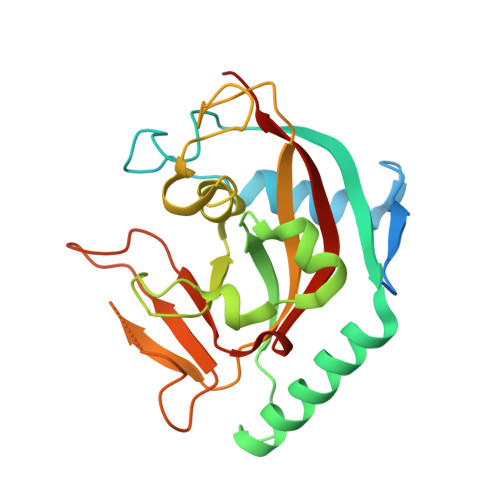Preclinical Lead Optimization of a 1,2,4-Triazole Based Tankyrase Inhibitor.
Waaler, J., Leenders, R.G.G., Sowa, S.T., Alam Brinch, S., Lycke, M., Nieczypor, P., Aertssen, S., Murthy, S., Galera-Prat, A., Damen, E., Wegert, A., Nazare, M., Lehtio, L., Krauss, S.(2020) J Med Chem 63: 6834-6846
- PubMed: 32511917
- DOI: https://doi.org/10.1021/acs.jmedchem.0c00208
- Primary Citation of Related Structures:
6TG4, 6TKM, 6TKN, 6TKP, 6TKQ, 6TKR, 6TKS - PubMed Abstract:
Tankyrases 1 and 2 are central biotargets in the WNT/β-catenin signaling and Hippo signaling pathways. We have previously developed tankyrase inhibitors bearing a 1,2,4-triazole moiety and binding predominantly to the adenosine binding site of the tankyrase catalytic domain. Here we describe a systematic structure-guided lead optimization approach of these tankyrase inhibitors. The central 1,2,4-triazole template and trans- cyclobutyl linker of the lead compound 1 were left unchanged, while side-group East, West, and South moieties were altered by introducing different building blocks defined as point mutations. The systematic study provided a novel series of compounds reaching picomolar IC 50 inhibition in WNT/β - catenin signaling cellular reporter assay. The novel optimized lead 13 resolves previous atropisomerism, solubility, and Caco-2 efflux liabilities. 13 shows a favorable ADME profile, including improved Caco-2 permeability and oral bioavailability in mice, and exhibits antiproliferative efficacy in the colon cancer cell line COLO 320DM in vitro.
Organizational Affiliation:
Hybrid Technology Hub-Centre of Excellence, Institute of Basic Medical Sciences, University of Oslo, P.O. Box 1110 Blindern, 0317 Oslo, Norway.
















